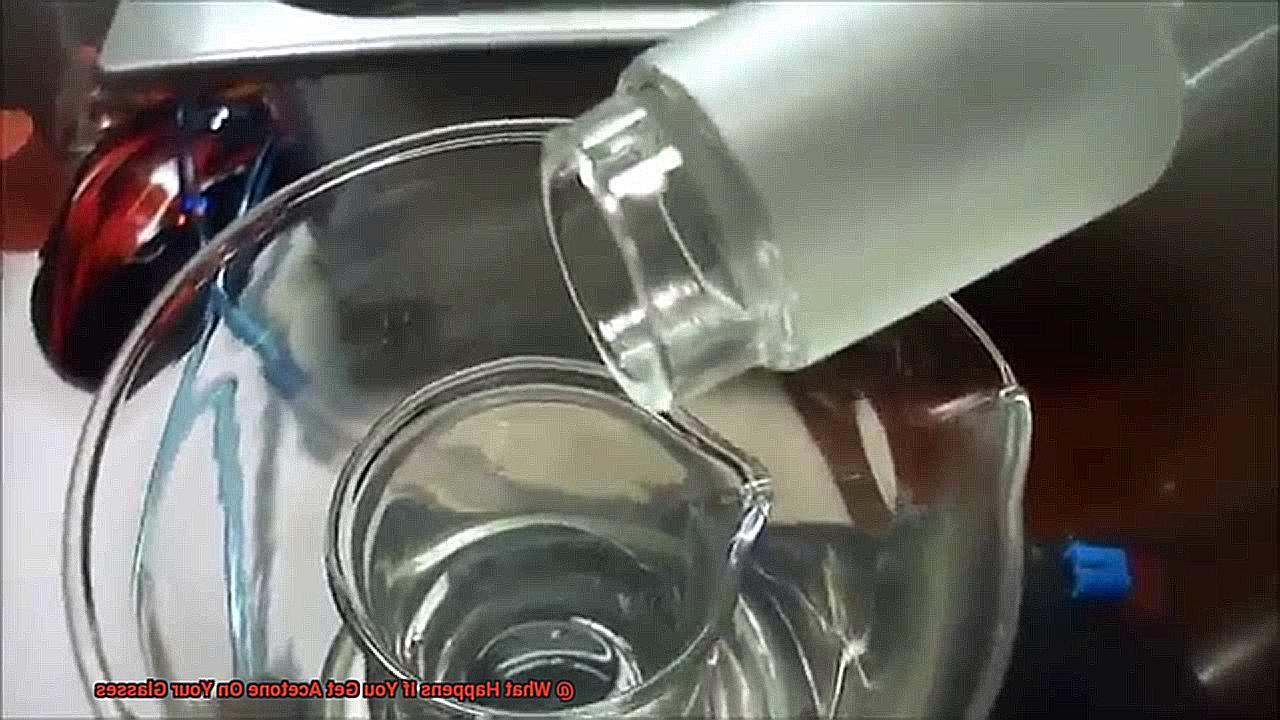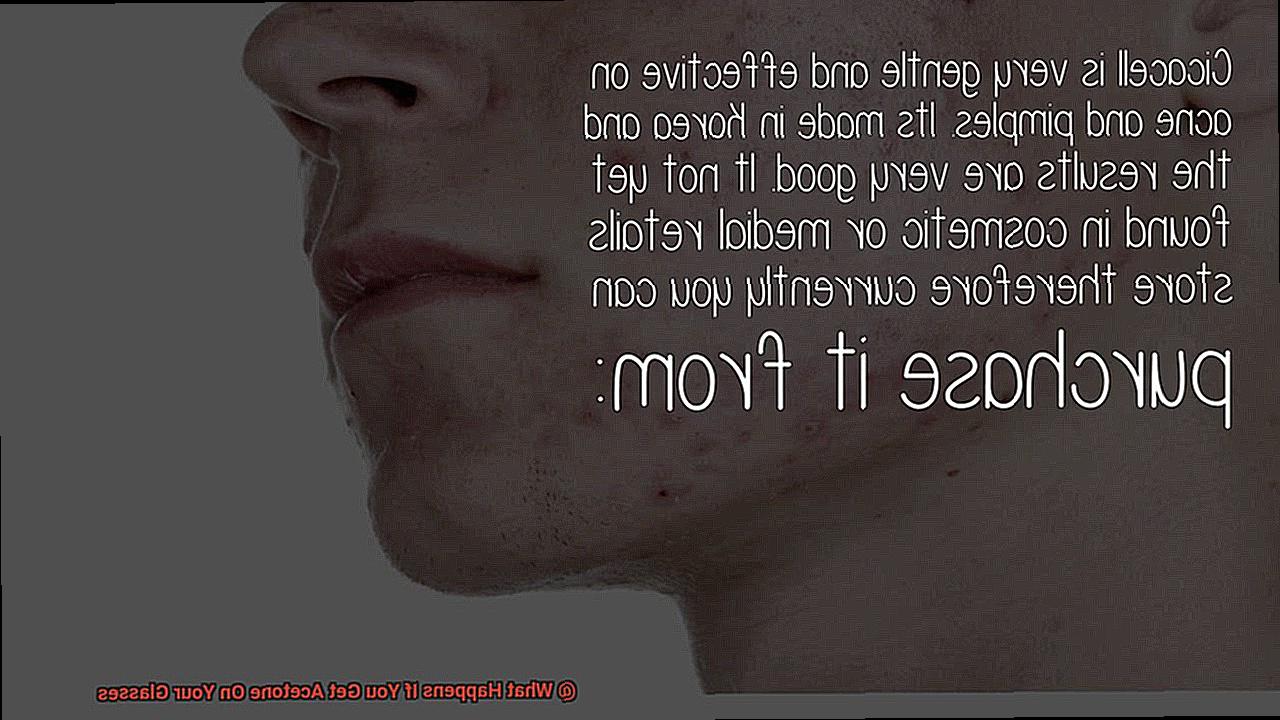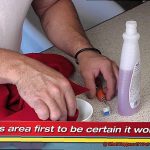Imagine this: you’re knee-deep in a DIY project, carefully painting your nails or getting crafty with some super strong adhesive. And then, out of nowhere, it happens. A tiny drop of acetone lands smack dab on your precious glasses. Cue the panic mode and the question that’s racing through your mind – “What the heck do I do now?”
Acetone, that sneaky little solvent found in nail polish removers, household cleaners, and all sorts of sticky stuff, has a knack for wreaking havoc on your eyewear. In this blog post, we’re about to uncover the potential consequences of an acetone-glasses encounter. So grab a seat and get ready to dive into this hidden menace.
What is Acetone?
Contents
If you have, then you know the frustration that comes with potential damage to your lenses. In this comprehensive guide, we will delve into the wonders of acetone, its effects on glasses, and provide you with preventive measures to safeguard your precious eyewear.
Understanding the Potency of Acetone on Glasses:
Vulnerability of Lens Materials:
- Some lens materials, such as polycarbonate and cellulose acetate propionate (CAP), are particularly susceptible to acetone damage.
- The corrosive nature of acetone can cause these lenses to become cloudy or develop intricate cracks.
- Conversely, glass lenses exhibit incredible resilience against acetone, making them less prone to damage.
Exposing Coating Vulnerabilities:
- Many glasses feature protective coatings that enhance durability, reduce glare, or provide UV protection.
- Unfortunately, acetone has the power to strip away these coatings, leaving lenses defenseless against scratches and compromising their effectiveness.

Minimizing Damage and Taking Preventive Measures:
Swift Action is Key:
- Act promptly if acetone accidentally comes into contact with your glasses.
- Carefully remove excess acetone using a clean, soft cloth or paper towel, avoiding excessive rubbing or applying too much pressure.
Rinse and Dry with Care:
- Gently rinse your glasses under lukewarm water to dilute any remaining acetone and wash away residue.
- Pat dry with a clean cloth and allow your glasses to air dry fully before donning them once again.
Expert Assistance:
- If damage appears irreversible, seek guidance from an optician or eyewear professional.
- These experts can assess the extent of the damage and recommend appropriate solutions such as lens replacement or repair.
Prevention Takes Priority:
- Prioritize the removal of glasses before using products containing acetone, such as nail polish removers or paint thinners.
- Store your glasses in a protective case when not in use to minimize the risk of accidental exposure to solvents.

Effects of Acetone on Different Types of Glasses
Curious minds often ponder the mysterious effects of acetone, that powerful solvent found in nail polish remover, on various types of glasses. Today, we embark on a journey to explore the intriguing world of acetone and its impact on glasses. Join us as we unravel the secrets that lie beneath the surface.
Heading 1: Dissolving Delicacy
Acetone, like a stealthy ninja, has the ability to dissolve certain components of your glasses. When acetone encounters specific types of glasses, it bids farewell to protective coatings that shield your lenses from scratches and glare. Unfortunately, this means saying goodbye to the very features that keep your glasses in pristine condition.
Heading 2: The Chromatic Conundrum
Beware. Acetone can initiate some rather unsightly transformations in your glasses. If your glasses are made from certain plastic materials, acetone may induce cloudiness or even alter their color. Imagine peering through hazy, oddly tinted lenses – not a pleasant sight indeed.
Heading 3: Fortified Guardians
But fear not, for not all glasses tremble in the presence of acetone. Some glasses are more resilient than others. Glasses crafted from tempered glass or those rich in silica (think sandy beaches.) possess an inherent strength against acetone’s advances. They stand tall like superheroes, safeguarding themselves against this stealthy solvent.
Heading 4: Fragile Companions
Acrylic and polycarbonate glasses may exude a cool vibe, but they prove to be rather fragile when faced with acetone. Acetone has the ability to render acrylic glasses brittle, making them prone to cracking or shattering into myriad pieces. Polycarbonate glasses commonly used in safety or sports eyewear can succumb to haziness or develop peculiar lines when exposed to acetone. Not the most enjoyable experience, to say the least.
Heading 5: A Word of Caution
Remember, even if acetone does not immediately manifest visible damage to your glasses, prolonged exposure or repeated contact can gradually diminish their quality and strength. Thus, it is essential to keep acetone far away from our precious glasses.
Potential Damage Caused by Acetone Exposure
Our glasses are more than just a fashion statement or a tool for clear vision – they’re also an investment. But there’s a lurking threat that can cause serious damage to your beloved eyewear: acetone. This powerful solvent, commonly found in glue, paint, and nail polish removers, can wreak havoc on your glasses if not handled with care.
Here, we’ll explore the potential damage caused by acetone exposure and share tips on prevention.
The Power of Acetone:
Acetone’s quick-dissolving properties make it a useful solvent for various tasks. However, when acetone comes into contact with glasses, it can lead to significant damage. Here’s what you need to know:
Brittle Frames and Lenses:
Due to its high evaporation rate, acetone rapidly dries out lens coatings and frames, making them brittle and prone to cracking or breaking.
Discoloration and Haze:
Certain lens materials, like polycarbonate or plastic, react with acetone, resulting in discoloration or cloudiness. This can impair vision clarity when wearing the glasses.
Stripped Protective Coatings:
Many glasses feature protective coatings like anti-glare or anti-reflective coatings. Unfortunately, acetone can strip away these coatings, leaving the lenses vulnerable to scratches and smudges.
Prevention is Key:
Understanding the potential damage caused by acetone exposure is crucial for protecting your glasses. Here are some prevention tips:
Handle with Care:
When using acetone-based products, wear gloves and protective eyewear if necessary. Accidents can happen, so it’s better to be safe than sorry.
Proper Storage:
Store acetone-containing products in a secure place away from glasses or other sensitive materials. A cabinet or drawer is ideal for keeping them out of harm’s way.
Rinse and Dry:
If acetone accidentally gets on your glasses, remove them immediately and rinse them under running water to dilute and remove any remaining acetone. Pat dry gently using a soft lint-free cloth, avoiding paper towels or tissues that may scratch the lenses.
Seek Professional Help:
If you notice traces of acetone or any damage to the lenses or frames, consult an optician or eyewear professional for assessment and potential repairs or replacements.
Quick Action to Minimize Damage from Acetone
Acetone, that sneaky solvent, can wreak havoc on our precious glasses. But fear not, my fellow glue enthusiasts. I’ve got a bag full of tricks to help minimize the damage and keep your specs looking fly.
First off, speed is key. When your glasses have had an unfortunate encounter with acetone, don’t waste a second. Rush to the sink and give them a thorough rinse with lukewarm water. Dilute that acetone and wash it away, my friend. But remember, no hot water or vigorous rubbing – we’re trying to save our precious lenses here.
Once you’ve given your glasses a refreshing rinse, it’s time to dry them off. Grab a soft, lint-free cloth and gently pat them down. Steer clear of tissues or paper towels – those sneaky culprits leave behind unwanted fibers and scratches. We want nothing but perfection for our beloved glasses.
Now, if those pesky stains or marks from the acetone are still lurking, it’s time to bring out the big guns – well, maybe not that dramatic, but a mild detergent or dish soap will do the trick. Dilute a small amount in water and grab a soft cloth or sponge. Gently scrub away those stubborn spots and watch them disappear like magic. Rinse again with water to remove any traces of soap and voila. Your shades are as good as new.
But hold on tight, my friend. If your glasses have coatings or special treatments, acetone might have dealt some irreversible damage. In this case, it’s time to call in the experts. Seek professional assistance from an optician or eyewear specialist who can work their magic and hopefully salvage your precious eyewear.
Now that we’ve tackled the immediate damage control, let’s talk prevention. Keep your glasses at a safe distance from this sneaky solvent whenever possible. If you find yourself working with acetone-based products or substances, consider using protective eyewear or, if it’s safe, removing your glasses altogether. Safety first, my friends.
Last but not least, proper storage is key. Keep acetone and other chemical products locked away in a secure place, far from the reach of curious kids and mischievous pets. And please, don’t forget to follow the manufacturer’s instructions for handling and disposal – let’s protect ourselves and our environment too.
Irreversible Damage from Acetone Exposure
Acetone, a powerful solvent commonly found in household and industrial products, can cause irreversible damage when exposed to certain materials, including glasses. The effects of acetone exposure on glasses can be devastating, leading to cloudiness, discoloration, and even loss of transparency. This solvent has a knack for dissolving the protective coating on lenses, leaving them vulnerable to damage from everyday wear and tear. Furthermore, acetone can weaken the frames of glasses, resulting in cracks, breakage, or warping.

The damage caused by acetone exposure may not be immediately noticeable but can worsen over time. The solvent slowly eats away at the protective coating, compromising the integrity of the lenses and reducing their lifespan. Additionally, weakened frames are more susceptible to damage and may become structurally unsound, posing a safety risk.
Prevention is crucial when it comes to protecting glasses from acetone exposure. Individuals should exercise caution when using products that contain this solvent and take necessary precautions to keep their glasses at a safe distance. Storing acetone securely away from curious kids and mischievous pets is essential for both their safety and the well-being of your glasses.
However, accidents do happen, and if acetone does come into contact with your glasses, immediate action is required. Rushing to the sink and rinsing them with lukewarm water is crucial to dilute and wash away the acetone before it can cause irreversible damage. It is important to note that hot water or vigorous rubbing should be avoided as it may exacerbate the damage. Once rinsed, gently pat dry with a soft, lint-free cloth to avoid introducing unwanted fibers or scratches.
In some cases, acetone exposure may have already caused irreparable damage to your glasses. If you notice persistent stains or significant deterioration despite your best efforts, seeking professional assistance from an optician or eyewear specialist is recommended. They have the expertise and tools necessary to assess the extent of the damage and provide appropriate solutions, such as lens replacement or frame repair.
It is also essential to consider the environmental impact of acetone exposure. Proper handling and disposal of products containing acetone are crucial to protect both human health and the environment. Following manufacturer instructions for disposal and ensuring that acetone is stored securely can help minimize its potential harm.
Preventing Accidental Contact with Acetone
Your glasses are not just a fashion statement; they are a gateway to the world. However, acetone, a crafty villain lurking in household and industrial products, can wreak havoc on your precious spectacles.
To protect your glasses from discoloration, weakened frames, or worse, it is essential to take precautions against accidental contact with acetone. In this article, we will explore effective measures to safeguard your glasses and maintain their pristine condition.
Handle with Care:
When working with acetone, always wear protective gloves. These gloves act as a barrier, shielding your skin from the harmful effects of this potent solvent.
Create a Safe Environment:
Ensure proper ventilation in the area where you use acetone to minimize inhalation risks. Additionally, work in a space away from your glasses to prevent accidental splashes or spills that could damage them.
Seal it Tight:
Always keep acetone containers tightly sealed when not in use. This prevents leaks or spills that could potentially harm your glasses if they come into contact with the solvent.
Remove and Store:
During activities involving acetone, such as painting or using nail polish remover, consider removing your glasses and storing them safely away from the work area. This simple step can eliminate the risk of accidental contact altogether.
Act Swiftly:
If acetone accidentally splashes onto your glasses, don’t delay. Immediately rinse them thoroughly with lukewarm water to dilute and remove the solvent. Avoid using harsh chemicals or solvents for cleaning, as they may further damage the glasses.
Seek Professional Help:
If the protective coating on your glasses is damaged due to acetone exposure, it may be necessary to have them professionally re-coated or replaced. Consult an optician or eyewear professional for tailored guidance based on your specific glasses and situation.
lu9v5UffIJ0″ >
Conclusion
In conclusion, it is abundantly clear that when acetone and glasses collide, chaos ensues. Acetone, the formidable solvent lurking in nail polish removers, household cleaners, and various other products, wields the power to wreak havoc on your beloved eyewear if mishandled. The potential aftermath of an acetone-glasses encounter is nothing short of a nightmare – think cloudiness, discoloration, weakened frames, vanished protective coatings, and worst-case scenario: cracks or breakage.
To salvage what’s left of your glasses after an unfortunate acetone incident, you must act swiftly and decisively. Grab a soft cloth or trusty paper towel to rid your lenses of any excess acetone. Then douse them under lukewarm water to dilute any lingering traces of this treacherous substance. Patience is key; allow your glasses to air dry completely before even contemplating wearing them again.
And if the damage seems insurmountable, do not hesitate to seek guidance from an esteemed optician or eyewear professional who can assess the extent of the devastation and propose suitable solutions.
But why wait for disaster to strike when prevention holds the key to protecting your precious spectacles from acetone’s malevolence? Make it a habit to remove your glasses before engaging in activities involving acetone-laden products. And when they’re not gracing your face with their stylish presence, ensure they find solace in a sturdy protective case. Handle any acetone-based concoctions with utmost care and adhere strictly to storage and disposal guidelines – no shortcuts allowed.
Bear in mind that prolonged exposure or repeated encounters with acetone will inevitably chip away at the quality and resilience of your cherished eyewear. So exercise caution at all times and take every necessary precaution to shield these optical marvels from the clutches of this sneaky solvent.






